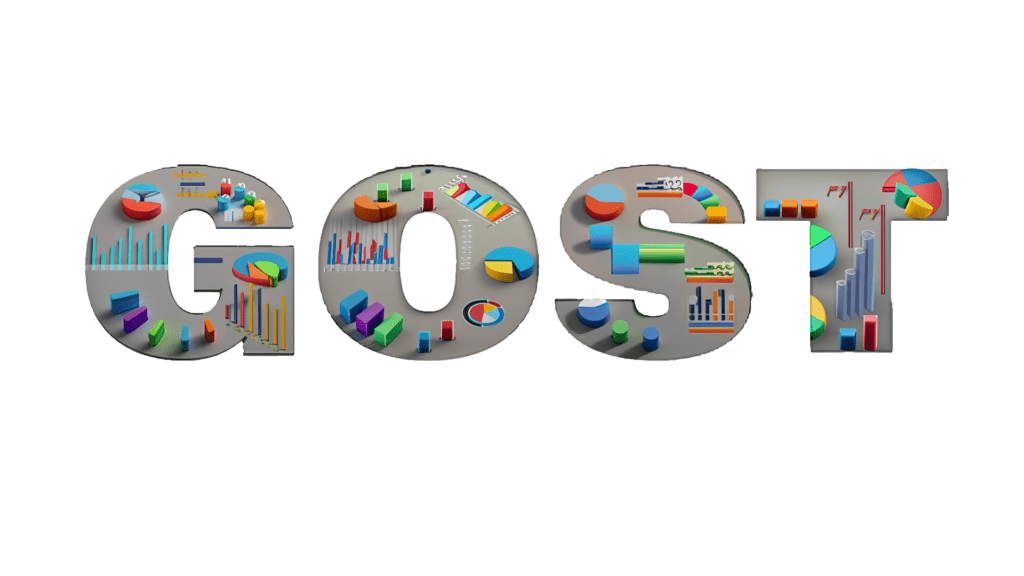Have you ever wondered why some businesses thrive while others struggle to stay afloat? The key lies in strategic planning, and understanding the Goal Objective Strategy Tactic (GOST) framework is crucial to unlocking the secrets of success. This comprehensive guide will walk you through the essentials of the GOST framework. Helping you establish a strong foundation for your business to soar.
Key Takeaways
The GOST framework provides a comprehensive model for businesses to organize their plans and achieve desired outcomes.
Goals, objectives, strategies and tactics are the four interconnected components of this model that require well-defined objectives & strategies for successful implementation.
Amazon’s success story serves as an example of how effective strategic planning can help businesses succeed in competitive environments while avoiding common mistakes in goal setting & execution.
The GOST Framework: An Overview

Navigating the complex world of business strategy can be daunting. The GOST framework simplifies strategic planning, allowing business leaders to focus on what truly matters: achieving their goals.
GOST stands for:
Goals
Objectives
Strategies
Tactics
It provides a comprehensive model for businesses to organize their plans, ensuring all efforts are geared towards the desired outcome.
A common pitfall many businesses face is setting unrealistic goals without any clear strategy or understanding how to achieve them. Disappointment and failure can be the result, even if a business is doing well. This business example demonstrates how important it is to stay focused and adhere to a plan.
The Four Pillars of GOST
The GOST model is built upon four interconnected components:
Goals: represent the desired outcomes or end results that organizations aim to achieve, such as increasing market share or improving customer satisfaction.
Objectives: the specific actions or steps businesses must take to reach their goals.
Strategies: pertain to long-term objectives.
Tactics: immediate actions.
Both strategies and tactics, including a well-executed communications strategy, should be based on well-defined objectives. Ensuring all efforts contribute to the accomplishment of ambitious goals and avoiding ineffective strategies.
For a successful GOST framework implementation, answer these critical questions before initiating a campaign: What are my multiple objectives? What actions should I take to accomplish my objectives? What are my strategies, and how will I execute them? Addressing these questions paves the way for a clear path to success, laying a solid foundation for the GOST framework.
Goals: Defining Your Desired Outcomes

Goals are the backbone of the GOST framework, acting as the guiding light for all business planning efforts. They are broad, long-term outcomes that a business aims to achieve, and they should align with the company’s vision and values.
Clear and achievable goals set the stage for success. Enabling businesses to concentrate their resources and efforts on the journey ahead.
SMART Goals
The SMART goal framework is a powerful tool that aids businesses in creating clear and achievable objectives. Acting as a cornerstone for success. SMART goals are:
Specific
Measurable
Attainable
Relevant
Time-bound
These goals provide a well-defined and structured approach for setting targets and monitoring progress towards their accomplishment. They articulate ideas, direct efforts, and boost productivity, ensuring the business stays on the right track.
Examples of SMART Goals include:
Increasing sales by 10% by the end of the year
Reducing customer complaints by 25% in the next quarter
Increasing customer satisfaction ratings by 5% in the next six months
Creating a clear roadmap to success and aligning all efforts towards achieving desired outcomes is facilitated by setting SMART goals.
Outcome-Oriented vs. Process-Oriented Goals
Appreciating the key differences between outcome-oriented and process-oriented goals is significant during business strategy planning. Successful goal setting heavily relies on this understanding. Outcome-oriented goals focus on the result, such as increasing customer loyalty or boosting retention. These goals clearly define the desired achievement or the specific impact intended to be made.
On the other hand, process-oriented goals emphasize the steps or processes required to achieve the desired outcome. They outline the actions, strategies, and behaviors that should be implemented to reach the goals. Striking the right balance between outcome-oriented and process-oriented goals ensures that your business remains adaptable and resilient in the face of challenges, while still keeping an eye on the ultimate prize.
Objectives: Mapping the Path to Success

Objectives are the building blocks that pave the way to achieving your goals. They are specific, measurable steps that lead to the realization of goals and provide a clear path to success. The breakdown of goals into smaller, actionable objectives allows businesses to maintain consistent progress and stay on course towards achieving their desired outcomes. Developing objectives is a crucial step in ensuring a business’s growth and success.
Crafting Actionable Objectives
Creating actionable objectives involves dividing goals into smaller, feasible tasks that can be allocated to individuals or departments. This process ensures that each member of the team has a clear understanding of their role and responsibilities. As well as the expectations placed upon them. By assigning tasks based on the respective skills and expertise of individuals or departments, businesses can optimize their resources and ensure that the right people are working on the right tasks to drive the company forward.
Crafting actionable objectives effectively requires acknowledging the steps needed to reach the goal and assigning each step to the appropriate individual or department. This ensures that everyone is working towards the same outcome and that resources are allocated effectively. Transforming goals into smaller tasks allows businesses to generate a clear roadmap for success and guarantees that team members comprehend their role in achieving desired outcomes.
Quantitative Measurements and Tracking Progress
Quantitative measurements are crucial for tracking progress towards objectives and ensuring that the business stays on track towards achieving its goals. These measurements refer to data that can be expressed numerically, such as:
sales figures
customer satisfaction ratings
website traffic
conversion rates
revenue growth
Businesses can use quantitative measurements to track progress, make required adjustments, and align all efforts towards the desired outcome.
Examples of quantitative measurements include numerical values such as sales figures or customer satisfaction ratings. Regular tracking of these measurements provides businesses with valuable performance insights and enables them to make data-driven decisions for optimizing their efforts. In turn, this helps ensure that objectives are being met and that the company is on track to achieve its overarching goals.
Strategies: Developing a Winning Game Plan

Strategies, including marketing strategy, are the plans of action designed to achieve goals and objectives. They should be aligned with the overall vision and values of the business, ensuring that all efforts are directed towards the desired outcomes.
Formulating a successful game plan requires the development of company strategy tailored to the organization’s specific needs and goals, while considering its unique challenges and opportunities.
Types of Business Strategies
There are three types of business strategies:
Corporate-level strategies determine the overall direction of the organization, setting the stage for growth and expansion.
Business-level strategies focus on competition within a particular market, outlining how the organization will differentiate itself from competitors and attract potential customers.
Functional-level strategies focus on specific functional areas within the organization, such as marketing, operations, or finance, and outline how these areas will contribute to the overall business strategy.
Functional-level strategies are concerned with optimizing specific activities within the organization, such as marketing, operations, or human resources. By developing and implementing strategies at each of these levels, businesses can create a cohesive and comprehensive plan for success, ensuring that all efforts are aligned with the overarching goals and objectives of the organization.
Aligning Strategies with Goals and Objectives
Aligning strategies with goals and objectives is critical for ensuring that all efforts are directed towards the desired outcomes. This process involves not only developing strategies that support the achievement of goals but also regularly reviewing and adjusting these strategies as needed to account for changing circumstances and new opportunities.
Effectively aligning strategies with goals and objectives necessitates the establishment of distinct organizational goals and their widespread communication throughout the organization. By doing so, businesses can ensure that all stakeholders are working towards the same outcome and can allocate resources effectively to achieve these goals.
Furthermore, regular monitoring and assessment of progress towards objectives can help identify areas for improvement and adjustments to the overall strategy, ensuring continued success and growth.
Tactics: Executing Your Plan

Tactics are the specific actions taken to execute strategies and achieve objectives. They are the practical steps that enable the organization to stay on course and make the necessary adjustments to ensure success.
A detailed action plan that concentrates all efforts on the successful execution of the overarching strategy can be created by clearly defining tactics and assigning responsibilities and due dates.
Creating Effective Tactics
Developing effective tactics involves creating a detailed plan of action, including deadlines and resources needed for successful execution. This process requires a thorough understanding of the team’s strengths and weaknesses, as well as a clear vision of the desired outcome. By analyzing past performance, observing team dynamics, and assessing individual abilities, businesses can identify key players and determine the formation and playing style that is best suited to their team.
Businesses can gather information about tactics and strategies from various sources such as:
Books
Articles
Videos
Tutorials
Seminars
Workshops
Insights of experienced coaches or players
By staying informed and up-to-date on the latest tactics and strategies, businesses can ensure that their plans remain relevant and effective in the ever-changing business landscape.
Assigning Responsibilities and Due Dates
Assigning responsibilities and due dates for tactics is crucial for ensuring accountability and helping to keep the business on track towards achieving its goals and objectives. This process involves identifying the tasks that must be completed, allocating those tasks to the relevant personnel, and establishing realistic deadlines for completion.
The importance of setting realistic deadlines lies in the timely completion of tasks and the ability of the business to achieve its goals and objectives. Furthermore, by clearly communicating expectations and providing adequate resources and support, businesses can foster a culture of accountability and ensure that all team members are working towards the same goals.
Real-World Examples: Goal, Objective, Strategy, and Tactic in Action

Real-world examples of successful GOST implementation, such as Amazon’s growth story, demonstrate the power of this strategic planning model. By examining these success stories, businesses can gain valuable insights into the application of the GOST framework and learn from the experiences of others to refine their own strategic planning processes.
Amazon’s GOST Success Story

Amazon’s GOST success story is a testament to its strategic planning and execution. Amazon, founded by Jeff Bezos in 1994, started as an online bookstore. It has since expanded into a multinational tech company specializing in e-commerce, digital streaming, cloud computing, and artificial intelligence. Amazon’s clear goal was to become the world’s most customer-centric company, and it set objectives that aligned with this goal. Such as expanding product lines and prioritizing customer service. The company’s strategies included diversification and technological innovation, and its tactics involved the rollout of services like Amazon Prime and Kindle. The effective implementation of the GOST framework has contributed to Amazon’s position as one of the world’s most valuable companies.
This success story serves as a powerful reminder of the importance of a well-implemented GOST framework in driving business growth. Drawing lessons from Amazon’s example allows businesses to refine their strategic planning processes, positioning themselves for success in a competitive business environment.
Lessons Learned from Successful GOST Implementation
Lessons learned from successful GOST implementation can provide valuable insights for businesses looking to improve their strategic planning processes. Examining these success stories enlightens businesses about the significance of setting clear goals and measurable objectives, maintaining focus on achieving outcomes, and utilizing the GOST model as a success framework.
Furthermore, successful GOST implementation stories offer valuable information on how to avoid common errors and missteps in strategic planning. By learning from the experiences of others, businesses can refine their own planning processes. Ensuring that they are well-equipped to navigate the challenges and opportunities that lie ahead.
Common Mistakes to Avoid in GOST Planning

Avoiding common mistakes in GOST planning is essential for ensuring the success of your strategic planning efforts. Some of these pitfalls include confusing goals with objectives, failing to align strategies with goals, and neglecting to assign responsibilities and due dates for tactics. By being aware of these potential errors, businesses can prevent ineffective planning, conserve resources, and capitalize on opportunities.
Developing a comprehensive yet succinct strategic plan, employing systems thinking, streamlining the planning process, and effectively communicating the plan to all relevant parties are crucial steps to avoid these mistakes. Additionally, establishing achievable goals, correlating goals to quantifiable results, and ensuring staff are informed of the plan can help businesses stay on track and achieve their desired outcomes.
Summary
In conclusion, the GOST framework offers a powerful tool for businesses to create a clear roadmap to success. Ensuring that all efforts are geared towards achieving the desired outcomes. By understanding the intricacies of goals, objectives, strategies, and tactics, and learning from real-world examples of successful GOST implementation, businesses can refine their strategic planning processes and set themselves up for success in a competitive business landscape. So, take the first step towards a brighter future for your business by embracing the GOST framewor. Unlocking the secrets to strategic planning success.
Frequently Asked Questions
What is the GOST model?
The GOST model is a business framework that stands for Goals, Objectives, Strategy, and Tactics. It assists companies in differentiating between objectives, activities, strategies and tactics so that they can develop plans to reach their long-term goals.
What is an example of a goal objective strategy tactic?
An example of a goal objective strategy tactic is to set an objective of losing 40lbs by the end of next year, supported by a strategy of exercising more and eating better, and finally implementing tactics such as going for a run every morning and eating salad 5 times a week.
What is the difference between strategic goals and tactical objectives?
Strategic goals are longer-term, broad plans that a business or individual wants to achieve. While tactical objectives are the shorter-term steps and actions taken to reach these goals. Tactical plans outline the specific actions that should be taken to accomplish strategic goals.
What is GOST marketing?
GOST is a marketing planning framework used to create effective corporate marketing plans. Consisting of Goals > Objectives > Strategies > Tactics that are connected in an organized hierarchy.
What does GOST stand for?
GOST stands for Goals, Objectives, Strategies, and Tactics, an effective plan used to achieve desired objectives.


